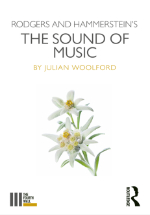 22 Titel umfasst die Buchserie »The Fourth Wall«, die der Verlag Routledge 2016 mit einem Band zu Harold Pinters »Party Time« startete. Der Verlag charakterisiert die Reihe folgendermaßen: »Fourth Wall books are short, accessible accounts of some of modern theatre’s best loved works. They take a subjective but easily digestible approach to their topics, allowing their authors the opportunity to explore their chosen subject in a way that is absorbing enough to be of use both to lovers of theatre and those who are being asked to study a play more deeply. Each book in the series looks at a specific play, variously exploring its themes, contexts and characteristics while prioritising original, insightful writing over complexity or scholarly weight.« Acht Bände widmen sich Musicals: »My Fair Lady«, »Sunday Afternoon«, »Into the Woods«, »Sweeney Todd«, »Les Misà©rables«, »Hedwig and the Angry Inch«, »The Book of Mormon« und, 2020 erschienen: »The Sound of Music«.
22 Titel umfasst die Buchserie »The Fourth Wall«, die der Verlag Routledge 2016 mit einem Band zu Harold Pinters »Party Time« startete. Der Verlag charakterisiert die Reihe folgendermaßen: »Fourth Wall books are short, accessible accounts of some of modern theatre’s best loved works. They take a subjective but easily digestible approach to their topics, allowing their authors the opportunity to explore their chosen subject in a way that is absorbing enough to be of use both to lovers of theatre and those who are being asked to study a play more deeply. Each book in the series looks at a specific play, variously exploring its themes, contexts and characteristics while prioritising original, insightful writing over complexity or scholarly weight.« Acht Bände widmen sich Musicals: »My Fair Lady«, »Sunday Afternoon«, »Into the Woods«, »Sweeney Todd«, »Les Misà©rables«, »Hedwig and the Angry Inch«, »The Book of Mormon« und, 2020 erschienen: »The Sound of Music«.
Eine erstaunliche Verlagsstrategie vorab. Band 1 (»Party Time«), ist (nach wie vor) in drei Kaufformaten erhältlich. Das 70 Seiten starke Buch kostet in der Hardcover-Ausgabe nicht weniger als 160 Pfund, als E-Book & Paperback 8,99 Pfund. 2017 senkte man den Hardcover-Preis neu erscheinender Titel auf 120 Pfund, seit 2018 werden keine Hardcover-Ausgaben neu veröffentlichter Werke dieser Serie angeboten. Nicht wirklich verwunderlich.
Julian Woolworth, Schauspielschulleiter, Regisseur und Schriftsteller, analysiert in seinem Büchlein zu »The Sound of Music« in erster Linie das Bühnenmusical, widmet sich aber auch den Filmversionen. Seine Methodik beruht darauf, Bezüge herzustellen. Er ordnet ein, etikettiert. So zeigt er Parallelen zwischen »The Sound of Music«, »King and I« auf. Das Musical sei »a rewrite of The King and I, a kindly governess battles a despotic father for the love of the children and brings liberalism into the household«m verortet das Werk in der Biografie von Rodgers und Hammerstein in vielerlei Hinsicht, flicht ein, dass »Edelweiss« das letzte gemeinsam geschriebene Lied ihrer letzten gemeinsamen Show sei. Er vernetzt das Musical mit der Gegenwart, etwa indem er die Bedeutung des Songs »Edelweiss« als Titelmelodie (gesungen von Jeanette Olsson) der nach einer literarischen Vorlage von Philip K. Dick entstandenen Fernsehserie »The Man in the High Castle« (Amazon Studio, 2015–2019) analysiert. Die Methode der Amerikaner, aus der Geschichte der Trapps und dem deutschsprachigen, in den USA gefloppten Film »Die Trapp Familie« (1956) letztlich einen Erfolg auf der Bühne und im Film zu machen, bezeichnet er als »Ghosting«: »As is so often the case with true stories, the effect is to alter the perception of the real events so that, after time, audiences believe they are seeing something that is closer to the truth than they actually are in reality and the adaptive choices made by writers are ignored. This is sometimes referred to as ghosting; a process by which stories become reinterpreted creatively and the true story becomes merely a ghost in the background.« Ein eigenes Kapitel ist dem späten Erfolg der Bühnenversion in Österreich gewidmet, hier illustriert er auf amüsante Weise, welche Bedeutung die Show da hat: »In 2014 a contestant on Die Millionen Show was asked a € 70,000 question that would surely have been in an earlier round in any other country: What small flower is the title of a song from The Sound of Music?. The contestant didn’t know the answer and, even after phoning a friend, she chose another flower, despite Edelweiss being the national flower of Austria.« Flott geschrieben, interessante Details als Highlights. Empfehlenswert.
Julian Woolford: Rodgers and Hammerstein’s »The Sound of Music« (The Fourth Wall). Abingdon 2020. 74 S.; (Paperback) ISBN: 978-1-138-68283-2. £ 6.99 routledge.com
Julian Woolford: Rodgers and Hammerstein’s »The Sound of Music« (The Fourth Wall) (2020)
»
Ihr Kommentar
HTML-Tags:
<a href="" title=""> <abbr title=""> <acronym title=""> <b> <blockquote cite=""> <code> <em> <i> <strike> <strong>






